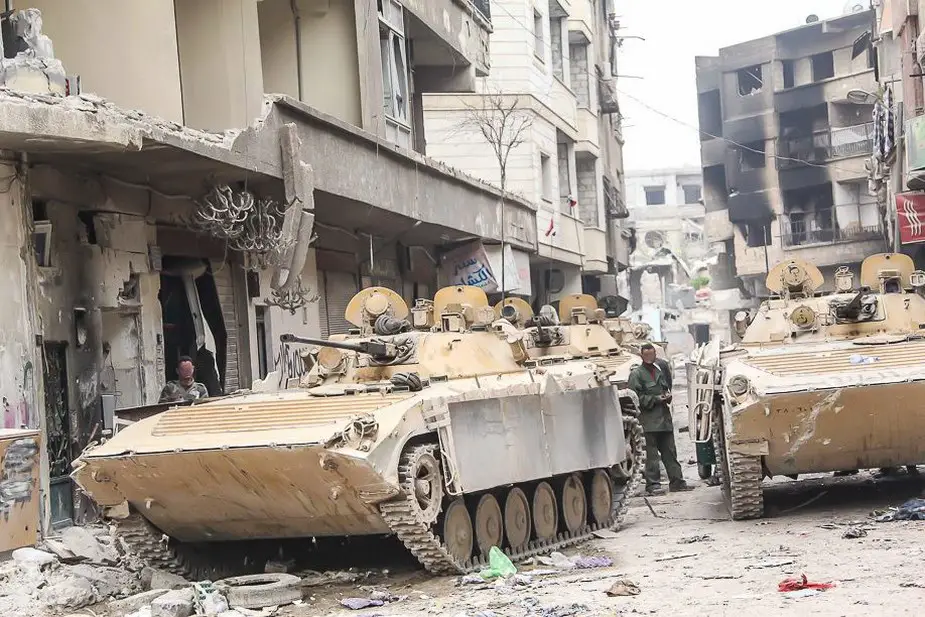Soviet-made IFVs and APCs in Syrian conflict
As of early 2017, the Syrian governmental troops operated some Soviet-made BMP-1 and BMP-2 IFVs. The BMP-1 is supposed to be the backbone of the Syrian mechanized infantry.

Syrian BMP-2 IFVs with improvised side skirts (Picture source: YouTube)
The BMP-1 is the 1st-generation of tracked infantry fighting vehicle that weighs some 12-13 tons (depending on the configuration) and is powered by a 300-hp UTD-20 diesel engine that enables the vehicle to reach a top speed of 65 km/h and a cruising range of 600 km. The vehicle crew totals three men, not including up to eight soldiers. The IFV`s armament suite integrates a 2A28 73mm rifled semi-automatic cannon with an ammunition load of 40 rounds, a Kalashnikov PKT 7.62mm coaxial medium machinegun with an ammunition load of 2,000 cartridges, and four 9M14 ‘AT-3 Sagger’ ATGMs, of which one is mounted on a launcher above the gun barrel. The vehicle`s sensor suite comprises a 1PN22M1 combined sighting system and an infrared searchlight.
The BMP-1 is a chassis for a large number of land platforms, with the BMP-1P being the most widespread. Unlike the baseline model, the BMP-1P features a roof-mounted launcher for the 9M111 Fagot ‘AT-4 Spigot’ or 9M113 Konkurs ‘AT-5 spandrel’ ATGMs and a bank of six 902B Tucha smoke dischargers at the rear of the turret. The updated IFV has been fitted with a modernized 1PN22M1-2 combined sight and new fire extinguishing subsystem. According to local media outlets, the Syrian troops intensively use BMP-1Ps in combat against terrorists. The governmental forces also operate some BMP-2s that are armed with low-caliber automatic cannons.
During counter-terrorism operations, the IFVs are used to provide fire support to dismounted troops. Due to a harsh operational environment. Some vehicles have been substantially upgraded. The BMP-1 is very vulnerable to rocket-propelled grenades and other anti-tank munitions. The Soviet troops deployed to Afghanistan in 1979-1989 used to fit the front and sides of the vehicles with appliqué armor plates. The modernized vehicle was designated BMP-1D. The platform lost its organic amphibious capabilities and the ATGM launcher in favor of an increased armor protection.
In this field, the Syrian governmental troops have followed in the steps of the Soviet servicemen. Some BMP-1s have received appliqué armor plates that protect the vehicle against 12.7mm armor-piercing bullets. The protection of some Syrian T-55s has been reinforced in this manner too.
The military sometimes replace the weapons of the IFV in the field. The organic 2A28 gun is effective against "technicals" (improvised fire support pick-up trucks) armed with heavy machineguns or ATGM systems. However, its anti-personnel capabilities are rather limited. In order to increase the vehicle`s firepower, some platforms have received ZU-23-2 23 mm anti-aircraft automatic cannons on top-open protected mounts.
The troops also use some "technicals" fitted with BMP-1`s turrets that feature a DShKM heavy machinegun instead of the baseline Malyutka launcher. Some BMP-1s have been fitted with eight rocket launchers. Several vehicles have received anti-HEAT side skirts and the Sarab jammers.
The Syrian governmental troops have received BMP-1-based support vehicles. For instances, the Republican Guard operates the Czechoslovakia -made AMB-S medical vehicle to evacuate casualties. The AMB-S is built on the chassis of the BVP-1 (Bojove vozidlo pechoty-1) that were produced in Czechoslovakia under license in 1979-1989. Some AMB-S have been rebuilt into IFVs and fitted with the ZU-23-2 cannon. The basic AMB-S has two racks for litters and medical subsystems. The vehicle weighs 13.6 tons and is powered by a 300-hp diesel engine that produces a top speed of 60 km/h, a swimming speed of 7 km/h, and a cruising range of some 700 km. The vehicle crew totals three men. The AMB-S is reported to be effective in combat.
According to Syrian media outlets, the governmental troops operate a BMP-1-based reconnaissance vehicles, namely, the BRM-1K.
Syria`s Republican Guard operates BMP-2 IFVs in the baseline configuration. The number of these vehicles is much less compared to that of the BMP-1.
Sometimes the Syrian military uses the MTLB multipurpose light armored tractors as IFVs. The vehicle`s organic armament suite that incorporates a PKT medium machinegun in a separate small turret is usually reinforced by the ZU-23-2 cannon, 12.7mm heavy machineguns or tripod-mounted automatic grenade launchers. The MTLBs are used due to the lack of BMP-1s and BMP-2s in frontline units.
As of early 2017, the APC inventory of the Syrian governmental troops comprised the following types: BTR-152, BTR-60, BTR-70, and BTR-80. Some tracked BTR-50 carriers have also been issued to the mechanized infantry. The baseline BTR-60 and BTR-70 APCs are obsolete, and the frontline units rarely drive them. At the same time, the military intensively uses the BTR-80s that have been additionally protected with bar-slat armor against anti-tank munitions.
In order to shore up the combat potential of the troops, some BTR-152s have been reactivated. These carriers have not been modernized, with armament suite (one to three Goryunov SGMB 7.62 mm medium machineguns) remaining the same.
The governmental troops have some BRDM-2 light reconnaissance vehicles and BRDM-2-based 9P133 Malyutka 9P148 Konkurs self-propelled anti-tank guided missile (SPATGM) systems. These vehicles have not been involved in operations against the terrorists. However, some BRDM-2s have received side-mounted bar-slat skirts and ZU-23-2 cannons.


























